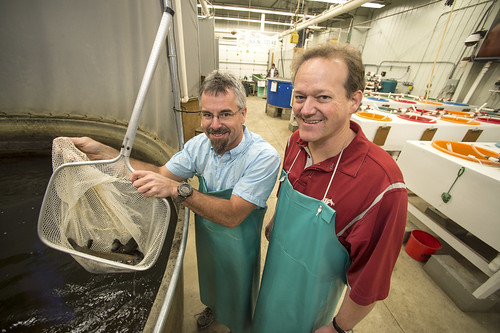
Researchers Dr. Kenneth Cain, University of Idaho, and Dr. Douglas Call, Washington State University, have developed a probiotic that fights Coldwater Disease in trout and salmon. They found the probiotic bacteria in the fish’s own gut. (Photo by Shelly Hanks, Washington State University)
After searching 15 years for a way to combat a devastating disease among salmonids (salmon and trout), researchers at Washington State University (WSU) and the University of Idaho (UI) found an answer inside the fish itself.
Dr. Kenneth Cain’s team at UI’s Aquaculture Research Institute cultured a bacteria from the fish’s gut (designated Enterobacter C6-6) and found that it inhibited the growth of Flavobacterium psychrophilum, the organism that causes Coldwater Disease.
Cain and Dr. Douglas Call, his WSU-based research partner since 2001, found that by adding C6-6 to fish feed as a probiotic they could limit the damage caused by Coldwater Disease – but they’re not quite sure why. “We know that C6-6 produces a toxin,” Call said. “This toxin kills the bacteria although we’re trying to get more funding to figure out how this works in the fish itself.”
Fish affected by Coldwater Disease suffer large open lesions that kill about a third of infected hatchery stock, the loss of which takes a large bite out of the worldwide $13.7 billion salmonid aquaculture industry. In Idaho, trout farms account for about 75 percent of U.S. and 50 percent of the global trout harvest, while Washington is the U.S. leader in producing trout eggs that are sold to hatcheries around the world. Hatchery fish may be sold as food or used to stock rivers and streams for recreational fishing.
Their findings are among the results of a four-year $325,000 study sponsored by the University of Washington-based Western Regional Aquaculture Center, which receives funding from USDA’s National Institute of Food and Agriculture (NIFA). The January 2015 issue of Applied and Environmental Microbiology contains a report of their work.
In addition to preventing economic loss to the aquaculture industry, this discovery shows that using probiotics as a preventive measure can limit the effect of the disease, should an outbreak occur. It also helps cut back on the use of antibiotics – and that’s a good thing, Call said.
“My research program is focused on reducing antibiotic resistance, and one important way to do this is by improving animal health and thereby reducing the demand for antibiotics,” he said. “This approach is a win-win for everyone – consumers, producers, and animals.”
NIFA invests in and advances agricultural research, education, and extension and seeks to make transformative discoveries that solve societal challenges.
No comments:
Post a Comment
Note: Only a member of this blog may post a comment.